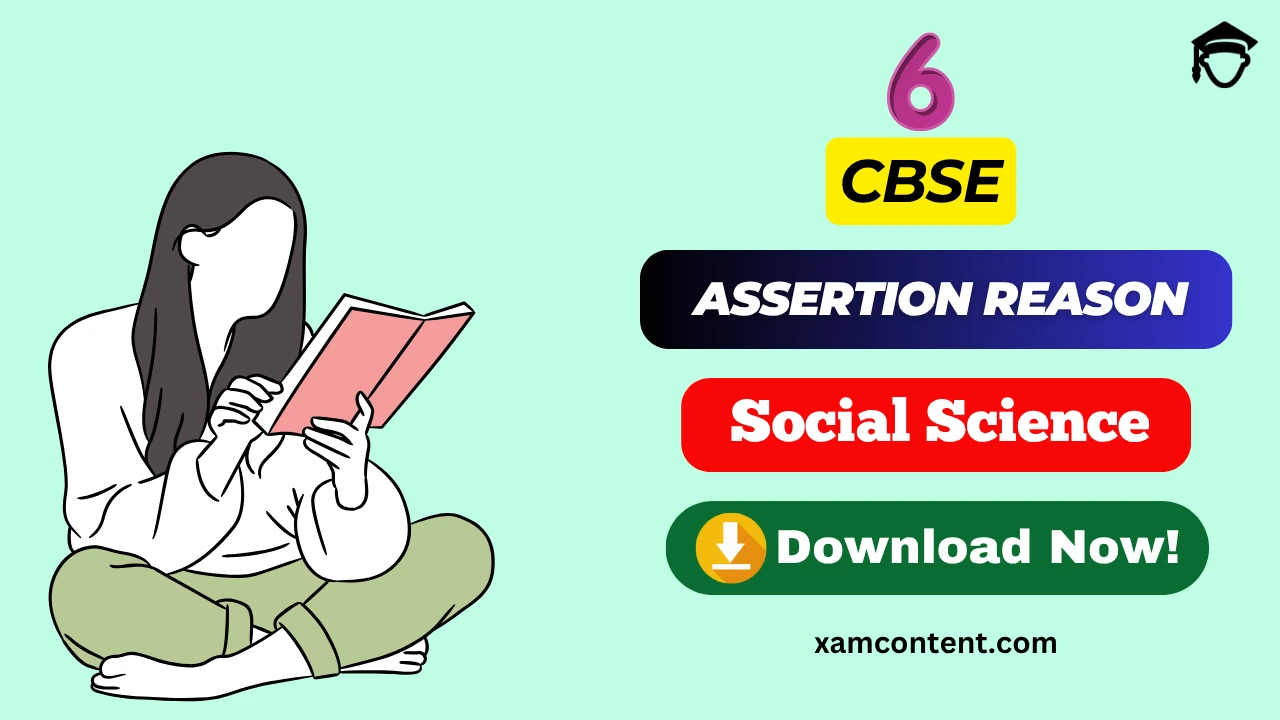Last Updated on November 16, 2025 by XAM CONTENT
Hello students, we are providing assertion reason questions for class 6. Assertion Reason questions are the new question format that is introduced in CBSE board. The resources for assertion reason questions are very less. So, to help students we have created chapterwise assertion reason questions for class 6 Social Science. In this article, you will find assertion reason questions for CBSE Class 6 Social Science Chapter 10 Grassroots Democracy Part 1 Governance. It is a part of Assertion Reason Questions for CBSE Class 6 Social Science Series.
| Chapter | Grassroots Democracy Part 1 Governance |
| Type of Questions | Assertion Reason Questions |
| Nature of Questions | Competency Based Questions |
| Board | CBSE |
| Class | 9 |
| Subject | Social Science |
| Useful for | Class 6 Studying Students |
| Answers provided | Yes |
| Difficulty level | Mentioned |
| Important Link | Class 6 Social Science Chapterwise Assertion Reason |
Assertion Reason Questions on Grassroots Democracy Part 1 Governance
Q1. Assertion (A): Governance refers to the process of making decisions and ensuring they are followed.
Reason (R): It includes creating laws, implementing them, and resolving conflicts through fair systems.
(a) Both A and R are true and R is the correct explanation of A.
(b) Both A and R are true but R is not the correct explanation of A.
(c) A is true but R is false.
(d) A is false but R is true.
Show Answer
Ans: (a)
Explanation: Both statements are true and connected: governance ensures order and justice through rule-making, execution, and adjudication.
Q2. Assertion (A): The judiciary is responsible for making new laws.
Reason (R): The judiciary interprets and applies existing laws while ensuring justice.
(a) Both A and R are true and R is the correct explanation of A.
(b) Both A and R are true but R is not the correct explanation of A.
(c) A is true but R is false.
(d) A is false but R is true.
Show Answer
Ans: (d)
Explanation: The assertion is false because legislatures make laws; the judiciary ensures justice and reviews lawfulness of decisions.
Q3. Assertion (A): The legislature, executive, and judiciary must remain separate to maintain checks and balances.
Reason (R): If one organ oversteps, the others can restore balance by reviewing its actions.
(a) Both A and R are true and R is the correct explanation of A.
(b) Both A and R are true but R is not the correct explanation of A.
(c) A is true but R is false.
(d) A is false but R is true.
Show Answer
Ans: (a)
Explanation: Both are true and related; the separation of powers prevents misuse of authority and promotes accountability.
Q4. Assertion (A): Local governments handle national and international issues like defence and foreign policy.
Reason (R): They mainly address local needs such as sanitation, roads, and basic services.
(a) Both A and R are true and R is the correct explanation of A.
(b) Both A and R are true but R is not the correct explanation of A.
(c) A is true but R is false.
(d) A is false but R is true.
Show Answer
Ans: (d)
Explanation: The assertion is false; national and international issues are handled by higher levels of government, while local bodies focus on community-level needs.
Q5. Assertion (A): India has only two levels of government — state and central.
Reason (R): In India, governance functions at three levels: local, state, and central.
(a) Both A and R are true and R is the correct explanation of A.
(b) Both A and R are true but R is not the correct explanation of A.
(c) A is true but R is false.
(d) A is false but R is true.
Show Answer
Ans: (d)
Explanation: The assertion is false; India has three tiers of government ensuring participation at all levels.
Q6. Assertion (A): Democracy means rule of the king or monarch.
Reason (R): It means rule by the people, through elected representatives in most countries.
(a) Both A and R are true and R is the correct explanation of A.
(b) Both A and R are true but R is not the correct explanation of A.
(c) A is true but R is false.
(d) A is false but R is true.
Show Answer
Ans: (d)
Explanation: The assertion is false; democracy literally means ‘rule of the people’ (demos + kratos).
Q7. Assertion (A): India follows a system of representative democracy.
Reason (R): Citizens elect leaders to make decisions and laws on their behalf.
(a) Both A and R are true and R is the correct explanation of A.
(b) Both A and R are true but R is not the correct explanation of A.
(c) A is true but R is false.
(d) A is false but R is true.
Show Answer
Ans: (a)
Explanation: Both statements are true and connected; India’s democracy works through elected representatives in assemblies and parliament.
Q8. Assertion (A): The legislature executes laws, while the executive interprets them.
Reason (R): The executive enforces laws, and the judiciary interprets them.
(a) Both A and R are true and R is the correct explanation of A.
(b) Both A and R are true but R is not the correct explanation of A.
(c) A is true but R is false.
(d) A is false but R is true.
Show Answer
Ans: (d)
Explanation: The assertion is false; each branch has a specific role—executive implements, legislature makes, and judiciary interprets laws.
We hope the given assertion reason questions with Answers for Grassroots Democracy Part 1 Governance Class 6 helps you in your learning.

Also check
- Class 6 Social Science Assertion Reason Questions Chapter 14 – Economic Activities Around Us
- Class 6 Social Science Assertion Reason Questions Chapter 13 – The Value of Work
- Class 6 Social Science Assertion Reason Questions Chapter 12 – Grassroots Democracy Part 3 Local Government in Urban Areas
- Class 6 Social Science Assertion Reason Questions Chapter 11 – Grassroots Democracy Part 2 Local Government in Rural Areas
- Class 6 Social Science Assertion Reason Questions Chapter 10 – Grassroots Democracy Part 1 Governance
- Class 6 Social Science Assertion Reason Questions Chapter 9 – Family and Community
- Class 6 Social Science Assertion Reason Questions Chapter 8 – Unity in Diversity
- Class 6 Social Science Assertion Reason Questions Chapter 7 – India’s Cultural Roots
- Class 6 Social Science Assertion Reason Questions Chapter 6 – The Beginings of Indian Civilisation
- Class 6 Social Science Assertion Reason Questions Chapter 5 – India, that is Bharat
- Class 6 Social Science Assertion Reason Questions Chapter 4 – Timeline and Sources of History
- Class 6 Social Science Assertion Reason Questions Chapter 3 – Landforms and Life
- Class 6 Social Science Assertion Reason Questions Chapter 2 – Ocean and Continents
- Class 6 Social Science Assertion Reason Questions Chapter 1 – Locating Places on Earth
Topics from which assertion reason questions may be asked
Assertion reason questions from the above given topic may be asked.

You may also like

Frequently Asked Questions (FAQs) on Grassroots Democracy Part 1 Governance Assertion Reason Questions Class 6
Q1: What are Assertion Reason Questions in Class 6 Social Science?
A1: Assertion Reason Questions are a new type of competency-based questions where students are given two statements — an Assertion (A) and a Reason (R). Students must decide whether each statement is true and whether the Reason correctly explains the Assertion.
Q2: How can Assertion Reason Questions help in exam preparation?
A2: These questions help students think critically, understand cause–effect relationships, and go beyond rote learning. They strengthen conceptual clarity in topics like History, Geography, and Civics by testing logical connections between facts.
Q3: How should students approach Assertion Reason Questions?
A3: Students should first read both statements carefully, identify whether each is true or false, and then check if the Reason actually explains the Assertion. Practicing chapter-wise Assertion Reason sets regularly improves accuracy and speed.
Q4: Are Assertion Reason Questions included in CBSE Class 6 syllabus?
A4: While Assertion Reason Questions are not directly mentioned in the NCERT syllabus, they are part of the new competency-based assessment pattern introduced by CBSE to promote conceptual understanding and analytical thinking.
Q5: What types of topics are covered in Class 6 Social Science Assertion Reason Questions?
A5: Topics include key chapters from History (e.g., What, Where, How and When?), Geography (e.g., The Earth in the Solar System), and Civics (e.g., Understanding Diversity) — focusing on reasoning, relationships, and application of knowledge.
Q6: Where can I find Assertion Reason Questions for Class 6 Social Science Chapter-wise?
A6: You can access free, chapter-wise Assertion Reason Questions with detailed explanations at xamcontent.com and physicsgurukul.com. These resources are designed as per the latest CBSE competency-based exam format.
Q7: What is meant by governance?
A7: Governance refers to the process of making decisions, creating rules, and ensuring they are followed so that society functions smoothly.
Q8: Why do we need a government?
A8: Government maintains law and order, provides public services, protects rights, resolves conflicts, and ensures development.
Q9: What are the three organs of government?
A9: The legislature makes laws, the executive implements them, and the judiciary interprets laws and ensures justice.
Q10: Why is the separation of powers important?
A10: Separation ensures that no single organ becomes too powerful. Each organ checks the other, maintaining balance and fairness.
Q11: What are the three levels of government in India?
A11: Local government, State government, and the Central (Union) government, each responsible for different types of administration.



